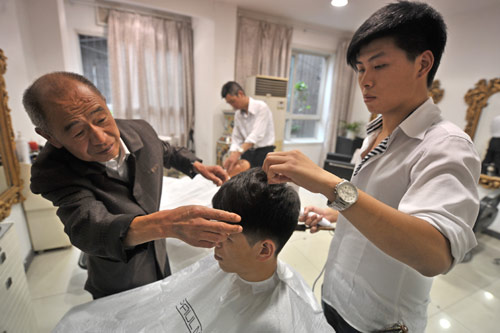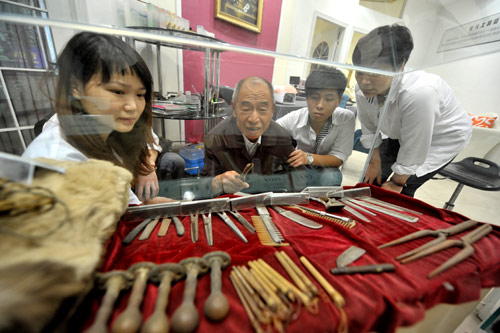
 |
|
Retired hairdresser Wu Ziwen, 76, instructs his 25-year-old grandson, Wu Cheng, at Changshengtang barber shop in Wuhan, Hubei province. Photos by Xiao Hao / For China Daily |
 |
|
Vintage hairdressing equipment is displayed on Changshengtang's second floor to document its development. |
Since 1911, a barber shop in Hubei province has preserved the hair-cutter's art in China, Han Bingbin reports.
What Hollywood hit film Bathing Beauty left behind after its smash-hit showing in China in the 1940s was something historic.
Locally called the "Esther hairstyle", named after the movie's lead actress Esther Williams, it created an enduring fashion wave that has washed over both everyday people and film stars in China for decades.
One of the persons who made the hairstyle accessible to Chinese fashion fans is Zhou Zishan, also nicknamed "the high nose".
Renowned for his solid hair-styling skills and a strong imitative ability, Zhou was then a very popular hairdresser in Central China's mega-city Wuhan, Hubei province, at a time when the hairstyling business for many still meant roving barbers serving people at their gates.
That's the sort of time-honored story you would hear at Changshengtang, meaning the "hall of longevity", China's first (according to records) and longest-lived barber shop.
Changshengtang was founded in 1911 by a veteran barber, Zhang Junian. It was said to be one of Kuomintang chief Chiang Kai-shek's favorite barber shops and where many other high-ranking Kuomintang officials had their hair cut for "longevity" before they fled to Taiwan in 1949.
Thanks to its advantageous location in the bustling French concession in Wuhan, its pioneering use of Western hairstyling techniques, such as permanent wave and also its auspicious name, it was not long before the shop became a must-go place for locals, especially the rich, to have their hair cut for birthdays.
Its glory endured, except for a little downturn during the War of Resistance against Japanese Aggression (1938-45), till 1952, when the shop became State-owned and started repeatedly changing its name.
In 1978, it resumed the name of Changshengtang. According to its 57-year-old manager Dai Furong, who has worked there for almost 40 years, it embarked on frequent renovations to keep reviving its fortunes.
The original store was expanded and the updated look included glass-curtain walls. Then an even more stylish new shop was opened to attract youths. Dai says they always try to be the first to bring in the most advanced Western equipment and techniques. They keep sending young hairstylists to be trained overseas, and these stylists have won many international hairdressing awards over the past two decades.
But two years ago, when some old people who returned from overseas mourned the change of its original look and recalled the glorious days of Changshengtang, Dai recognized its historical value.
Based on their memories, she changed the shop to its original European-style look. Meanwhile, Dai has found all the old equipment from the store, which is now displayed on the second floor to document China's hair-styling business from the 1920s to the 1990s.